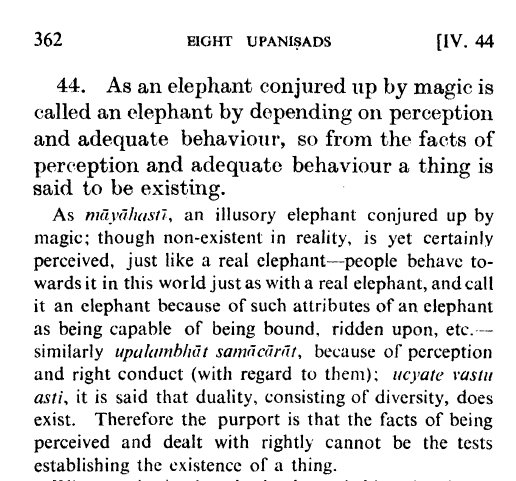agreement between Sri Nisarga-datta-maharaj and Sri Shankara-prasthana-traya bhashyas
Krishna Kashyap
V Subrahmanian
उपलम्भात्समाचारादस्तिवस्तुत्ववादिनाम् ।
जातिस्तु देशिता बुद्धैरजातेस्त्रसतां सदा ॥ ४२ ॥
अजातेस्त्रसतां तेषामुपलम्भाद्वियन्ति ये ।
जातिदोषा न सेत्स्यन्ति दोषोऽप्यल्पो भविष्यति ॥ ४३ ॥
उपलम्भात्समाचारान्मायाहस्ती यथोच्यते ।
उपलम्भात्समाचारादस्ति वस्तु तथोच्यते ॥ ४४ ॥



Namaste, thanks.Best Regards,Krishna Kashyap
--
You received this message because you are subscribed to the Google Groups "भारतीयविद्वत्परिषत्" group.
To unsubscribe from this group and stop receiving emails from it, send an email to bvparishat+...@googlegroups.com.
To view this discussion on the web visit https://groups.google.com/d/msgid/bvparishat/CANkLSMkuj7t-pXv4pLnCGU%2B%3DzsfDFcEdyN8sr-xcEPDX5TJ30g%40mail.gmail.com.
Krishna Kashyap
दैवी ह्येषा गुणमयी मम माया दुरत्यया।
मामेव ये प्रपद्यन्ते मायामेतां तरन्ति ते।।7.14।।
।।7.14।। दैवी देवस्य मम ईश्वरस्य विष्णोः स्वभावभूता हि यस्मात् एषा यथोक्ता गुणमयी मम माया दुरत्यया दुःखेन अत्ययः अतिक्रमणं यस्याः सा दुरत्यया। तत्र एवं सति सर्वधर्मान् परित्यज्य मामेव मायाविनं स्वात्मभूतं सर्वात्मना ये प्रपद्यन्ते ते मायाम् एतां सर्वभूतमोहिनीं तरन्ति अतिक्रामन्ति ते संसारबन्धनात् मुच्यन्ते इत्यर्थः।।यदि त्वां प्रपन्नाः मायामेतां तरन्ति कस्मात् त्वामेव सर्वे न प्रपद्यन्ते इत्युच्यते
*******************
To view this discussion on the web visit https://groups.google.com/d/msgid/bvparishat/CAKk0Te00vHuKkAOWgL6c9%2BwMCQGMcy3oYuv3L-1iLD7wr-a-sQ%40mail.gmail.com.
Krishna Kashyap
V Subrahmanian
Since I am dealing with mainly bhagavadgita now, please send me proof or testimony using the Shankara-bhagavad-gita bhashya If possible.I am not getting that view of Sri-Nisarga-datta-maharaj in the shankara-gita-bhashya.Or I am missing something.I will look into the Mandukyabhashya as suggested by you. I will let you know once I study it carefully.for example the bhashya on
दैवी ह्येषा गुणमयी मम माया दुरत्यया।
मामेव ये प्रपद्यन्ते मायामेतां तरन्ति ते।।7.14।।
Sanskrit Commentary By Sri Shankaracharya।।7.14।। दैवी देवस्य मम ईश्वरस्य विष्णोः स्वभावभूता हि यस्मात् एषा यथोक्ता गुणमयी मम माया दुरत्यया दुःखेन अत्ययः अतिक्रमणं यस्याः सा दुरत्यया। तत्र एवं सति सर्वधर्मान् परित्यज्य मामेव मायाविनं स्वात्मभूतं सर्वात्मना ये प्रपद्यन्ते ते मायाम् एतां सर्वभूतमोहिनीं तरन्ति अतिक्रामन्ति ते संसारबन्धनात् मुच्यन्ते इत्यर्थः।।यदि त्वां प्रपन्नाः मायामेतां तरन्ति कस्मात् त्वामेव सर्वे न प्रपद्यन्ते इत्युच्यते
On Thu, Sep 16, 2021 at 2:09 PM V Subrahmanian <v.subra...@gmail.com> wrote:Here I do not get the feeling from Sri shankarabhashya that Bhagavan is caused due to MAYA. maya is a power of Bhagavan as per this shloka.maam eva maayavinam, does not give me a feeling that saguna brahman is a product of maya.
न कर्तृत्वं न कर्माणि लोकस्य सृजति प्रभुः ।
न कर्मफलसंयोगं स्वभावस्तु प्रवर्तते ॥ १४ ॥
नादत्ते कस्यचित्पापं न चैव सुकृतं विभुः ।
अज्ञानेनावृतं ज्ञानं तेन मुह्यन्ति जन्तवः ॥ १५ ॥
Venkatraghavan S
Krishna Kashyap
To view this discussion on the web visit https://groups.google.com/d/msgid/bvparishat/CAKk0Te00vHuKkAOWgL6c9%2BwMCQGMcy3oYuv3L-1iLD7wr-a-sQ%40mail.gmail.com.
Krishna Kashyap
श्री भगवानुवाच
असंशयं महाबाहो मनो दुर्निग्रहं चलं।
अभ्यासेन तु कौन्तेय वैराग्येण च गृह्यते।।6.35।।
।।6.35।। असंशयं नास्ति संशयः मनो दुर्निग्रहं चलम् इत्यत्र हे महाबाहो। किंतु अभ्यासेन तु अभ्यासो नाम चित्तभूमौ कस्यांचित् समानप्रत्ययावृत्तिः चित्तस्य। वैराग्येण वैराग्यं नाम दृष्टादृष्टेष्टभोगेषु दोषदर्शनाभ्यासात् वैतृष्ण्यम्। तेन च वैराग्येण गृह्यते विक्षेपरूपः प्रचारः चित्तस्य। एवं तत् मनः गृह्यते निगृह्यते निरुध्यते इत्यर्थः।।यः पुनः असंयतात्मा तेन
--
You received this message because you are subscribed to the Google Groups "भारतीयविद्वत्परिषत्" group.
To unsubscribe from this group and stop receiving emails from it, send an email to bvparishat+...@googlegroups.com.
To view this discussion on the web visit https://groups.google.com/d/msgid/bvparishat/938ca3ec-02a2-4cba-8a09-c0651d5b7520n%40googlegroups.com.
